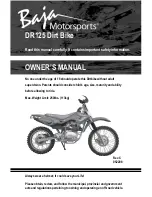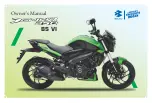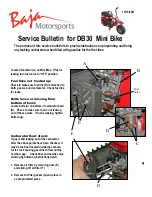
O
p
er
at
io
n Gu
id
e
64
Airbag System
The Airbag System can help cushion the
impact force to the rider’s head and upper
body in certain severe frontal impacts.
For safety precautions, see “Airbag
system.”
How Rider Injuries Occur in a
Frontal Crash
“SPEED KILLS,” a saying goes. But not all
vehicle injuries occur at high speeds, and
speed alone does not cause injuries.
In fact, the main cause of injuries in a
collision is a rapid decrease in speed, caused
by the rider impacting an object, such as
another vehicle or the ground. As another
saying goes, “It’s not how fast you go, it’s
how hard you hit.”
Consider, for example, what happens
when a vehicle and rider crash into a
parked car at 30 mph (50 km/h).
• In a 30 mph (50 km/h), head-on crash
into the side of a stationary car, the
vehicle will come to a stop in about 1/
10th of a second-nearly as fast as the
blink of an eye.
Without an airbag, the rider would
continue forward at 30 mph (50 km/h)
until he strikes the car or the ground
with a force that could cause very serious
or fatal injuries.
• In the same situation with an airbag-
equipped vehicle, the bag would slow
the rider’s forward movement and
absorb some of his kinetic energy.*
As a result, the rider would impact the car
and/or the ground at a lower speed and
with less force, and have a better chance of
surviving the crash.
*Kinetic energy (KE) is the energy of motion. For a
rider, it’s a combination of the rider’s mass (m) or
weight, and his speed (v).
Mathematically, KE = (m x v2)/2. At 30 mph (50
km/h), a rider’s kinetic energy is four times greater
than at 15 mph (24 km/h). At 45 mph (72 km/h), it
would be nine times greater.
At 60 mph (100 km/h), it would be sixteen times
greater.
• A crash into a solid barrier at 30 mph (50
km/h) may not seem very serious, but for
the rider it would be similar to falling
from a third-story building directly onto
pavement.
GL1800DA
















































